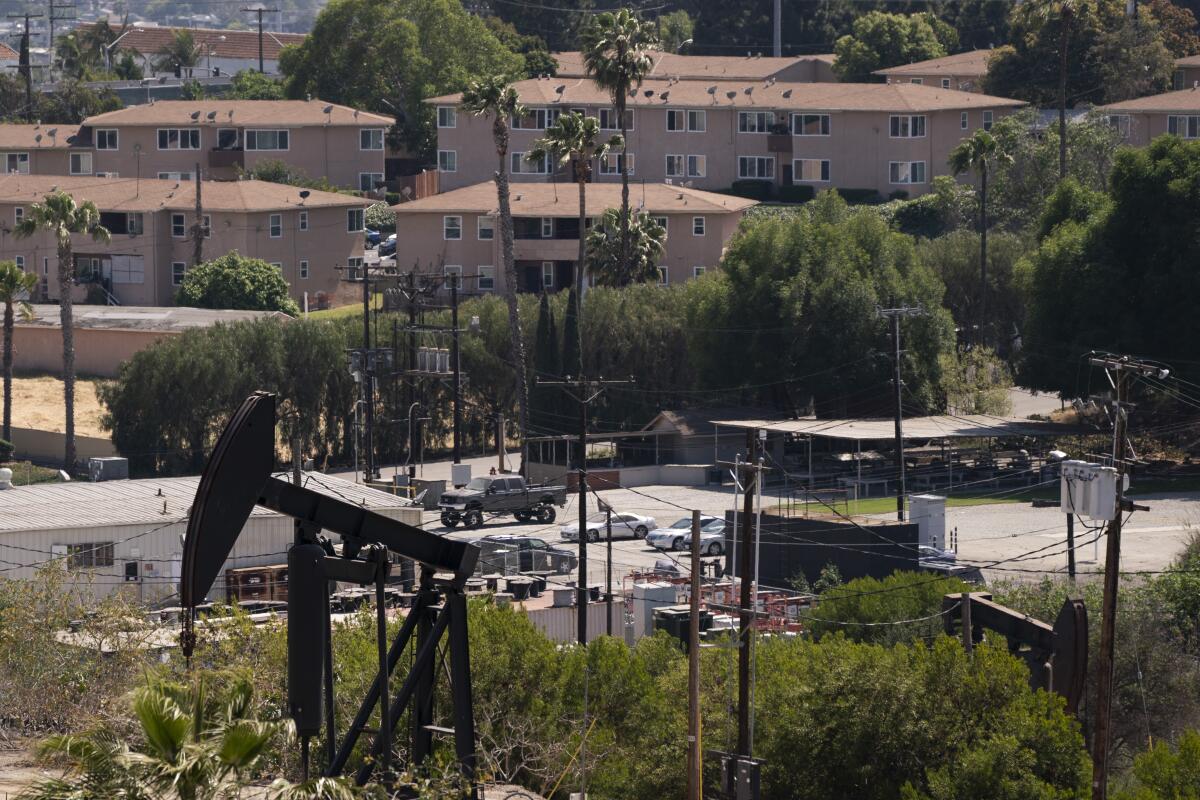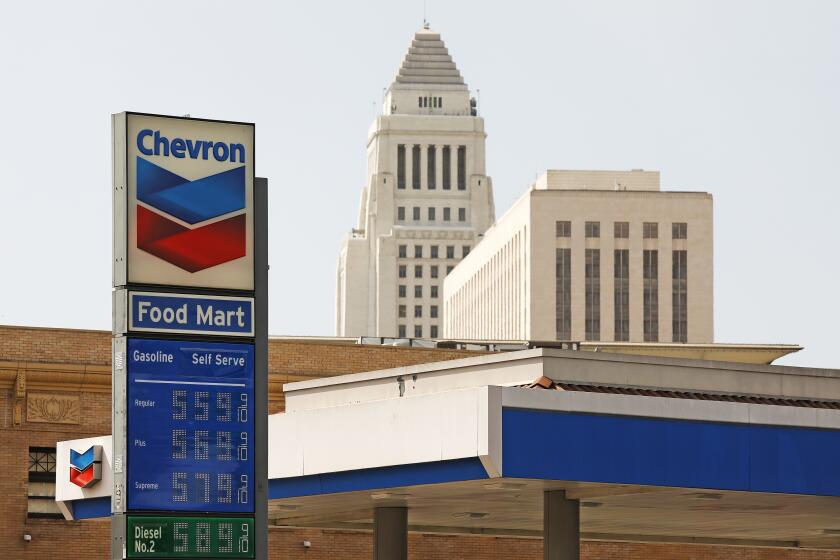Column: Oil and gas drillers mobilize to kill a key California environmental rule

- Share via
The oil and gas industry, which has been accustomed to getting its own way from California regulators for decades, suffered a rare defeat this year.
That happened in September, when Gov. Gavin Newsom signed Senate Bill 1137, which requires a minimum distance between new oil and gas wells and places of human habitation and work, such as homes, schools and healthcare facilities.
That distance is 3,200 feet — about two-thirds of a mile or roughly one kilometer. More than 2 million Californians live within that distance from an active oil or gas well, disproportionately low-income residents or people of color.
To say that [the standard] is scientifically unfounded is just not paying attention to the overwhelming evidence that is out there.
— Rachel Morello-Frosch, UC Berkeley
If you thought the industry would slink away and accept its loss in Sacramento, you don’t know our oil drillers.
Instead, they’ve mounted a multimillion-dollar campaign to overturn the law at the ballot box. On Wednesday, they crowed that they had collected more than 978,000 signatures to place a referendum to that effect on the 2024 ballot.
Get the latest from Michael Hiltzik
Commentary on economics and more from a Pulitzer Prize winner.
You may occasionally receive promotional content from the Los Angeles Times.
To date, their war chest weighs in at more than $20 million, raised chiefly from independent oil and gas drillers. You can expect it to swell much, much more because of how much is at stake; California produced about 146 million barrels of crude oil in 2021, worth roughly $10 billion to $12 billion at current prices.
You can also expect that war chest to be spent on a campaign of deceit and balderdash typical of attempts by businesses to overturn regulations they don’t like (which is most of them).
We can say this because the process is already underway. The oil and gas drillers have promoted their proposed referendum with the slogan “Stop the Energy Shutdown.”
That suggests that the law would close existing wells and forbid new ones, which isn’t at all true: SB 1137 applies the minimum distance rule only to new and reworked wells, and only requires more extensive environmental reporting from existing wells. Nothing is being “shut down.”
DaVita and Fresenius earn billions of dollars a year, but they say Proposition 29 would hurt them by requiring more healthcare professionals in their dialysis clinics.
The referendum campaign launched by the California Independent Petroleum Assn. (CIPA) is merely the latest in a string of efforts by big business to override California laws at the ballot box.
The epitome is Proposition 22, the 2020 referendum funded by Lyft, Uber and other gig companies aimed at exempting themselves from a state law clamping down on their misclassification of drivers and delivery workers as independent contractors rather than employees.
The companies succeeded with a campaign costing more than $200 million, a record, depriving their workers of minimum wage, workers’ compensation and other protections. Proposition 22 is currently being reviewed in state court.
Also in 2020, the bail bond industry — comprising huge international insurance companies masquerading as mom-and-pop storefronts — succeeded in repealing a California law eliminating cash bail. The repeal was a blow for efforts to reform a feature of the judicial system profoundly infected with racial bias.
The 2024 state ballot is likely to see a challenge by the restaurant industry against a 2022 state law establishing minimum wage and workplace protection rules for fast-food workers. The industry has submitted more than 1 million petition signatures, well beyond the 623,000 required to place the referendum before voters.
The referendum process benefits the laws’ targets even if they don’t ultimately prevail at the ballot box. That’s because a law can’t go into effect while an active referendum is awaiting a vote.
Referendums can be held only during general elections, which occur every two years. If the oil and gas referendum qualifies, the setback law would be suspended until at least the end of 2024, rather than going into effect this Jan. 1.
It’s proper to note a salient point of CIPA’s history. The organization took an especially aggressive stance against drillers’ environmentalist critics starting in 2015, but it ended up shooting itself in the foot.
The critics challenged the indulgent policies of the city of Los Angeles, which they contended was rubber-stamping oil drilling permits in violation of the California Environmental Quality Act. They accused the city of being especially lax about drilling applications in and near majority Latino and Black communities.
After the city tightened its procedures, CIPA sued the environmental groups. A state appeals court threw out the lawsuit and ordered CIPA to pay $2.3 million in defendants’ legal fees. Embarrassingly, CIPA had to file for bankruptcy. Its reorganization plan was finally approved in Bankruptcy Court in September.
The California Independent Petroleum Assn., or CIPA, sued its critics and lost a $2.3-million judgment. That’s how it found itself in bankruptcy.
The industry campaign against the new minimum setback rule began even before Newsom signed SB 1137 on Sept. 16. While the measure was making its way through the Legislature, the California Chamber of Commerce placed it on its “job killer” list. That was as sure a signal as one could hope to find that the law favored the public interest over corporate interests, just like the law overturned by Proposition 22 and the fast-food law in the restaurant industry’s gun sights.
The industry’s chief assertion is that by hampering new well development, the law will force California refineries to buy more supply from overseas, which will drive up prices at the pump. The drillers also say that the 3,200-foot standard is “without any scientific basis.”
Both claims are false. Let’s take them one at a time.
The pocketbook argument is always industry’s trump card when it tries to fight a new law or regulation. You know the drill: “This law is going to cost you money.” In this case, it’s blowing smoke. California crude prices reflect the global oil market; whether California wells produce a drop of oil more or less — or even thousands of barrels a day more or less — has zero impact on what you pay at the pump.
As my colleagues Laurence Darmiento, Sean Greene and Vanessa Martínez reported, among the key non-global contributors to gasoline prices in California are refinery profit margins, which for an unexplained reason average more than 69 cents per gallon on the West Coast compared to 54 cents nationally.
CIPA contends that California refineries have to pay more for imported oil because of the cost of transport, but that’s a marginal factor, since nearly four-fifths of the oil consumed in California comes from overseas anyway.
And it’s not as if California drillers are capable of stepping up their output if only they could sink wells anywhere they wish.
The truth is that the productive capacity of the state’s oil fields has been declining for years — the current output is only about one-third of what it was in the mid-1980s. That’s not because the drillers are hamstrung by rules and regulations, but because there’s simply not as much oil to be found as there used to be.
CIPA says that SB 1137 is unnecessary because “existing state and local laws already required various setback distances from oil wells established by thoughtful scientific review.”
That’s misleading, at best. Local laws typically require setbacks of no more than 300 to 500 feet. Before SB 1137, no statewide law addressed the health hazards of oil and gas wells through distancing requirements, though state fire regulations prohibit drilling wells within 300 feet of schools, healthcare facilities, prisons and “places of assembly” such as churches.
Proposition 22 is a revolutionary step in the influence of tech-based businesses in our daily lives in general and the lives of workers in particular.
That brings us to CIPA’s assertion about the science behind the 3,200-foot rule — or rather, its absurd argument that no scientific basis exists.
The standard written into SB 1137 is based on the findings of a 15-member scientific advisory panel that reported in 2021 to the California Geologic Energy Management Division, or CalGEM. The panel examined more than 60 peer-reviewed studies of the relationship between oil and gas development activities and health issues in neighboring communities.
“To say that [the standard] is scientifically unfounded is just not paying attention to the overwhelming evidence that is out there,” says Rachel Morello-Frosch, an expert in environmental health and policy at UC Berkeley and co-chair of the CalGEM scientific panel. “Tons of studies that have looked precisely at the distance of one kilometer. It wasn’t pulled out of the air.”
What was most striking about the studies was the “consistency of results,” says Seth B.C. Shonkoff, executive director of the Oakland-based research institute PSE Healthy Energy and the scientific panel’s other co-chair.
“These studies were conducted using different methodologies, in different locations, with diverse populations and in different time periods,” Shonkoff told me, yet all found a relationship between oil and gas drilling and health effects on local populations, including low birth weights of newborns, premature deliveries, respiratory ailments and leukemia.
Some studies focused on the particular substances and conditions that residents near active wells are exposed to, Morello-Frosch says. Wells emit a volatile miasma of cancer-causing hydrocarbons such as benzene and toluene, and their wastewater can contaminate underground water tables relied on by neighbors for household supplies.
Not only do these operations contribute to air and water pollution, but they also produce noise and light pollution that some studies have found increase the risk of cardiovascular conditions such as hypertension and sleep deprivation that can affect residents’ mental health.
Low-income communities became clustered around oil fields — or, rather, drilling was allowed to become intensified near vulnerable communities — before modern concerns about environmental justice were taken seriously. As a result, millions of nearby residents can be bombarded not merely by isolated or discrete pollution sources, but widespread assaults by multiple and voluminous pollutants.
If CIPA’s referendum is qualified for the ballot, voters statewide — not only those living and working in close proximity to oil and gas wells — will be facing an entirely different form of pollution: the pollution of the airwaves and mailboxes that rises when well-funded industries try to snow Californians into voting against their best interests.
More to Read
Get the latest from Michael Hiltzik
Commentary on economics and more from a Pulitzer Prize winner.
You may occasionally receive promotional content from the Los Angeles Times.














